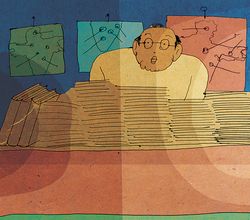The year was 1998. Airports and flights weren’t what they are now. Waiting at Delhi airport for an interminably delayed flight, I ran into a friend who used to work for a chamber of commerce (CC). Discussing research we might do for the CC, I suggested the idea of ranking India’s states and he leapt at it. Ranking states is routine now. Choose a bunch of variables, get data, attach weights, aggregate and construct an index. Back then, data on states was hard to get, especially on social sectors. That’s how Laveesh Bhandari and I started ranking states. (There were no surveys, no subjective responses to questionnaires. Numbers used were hard objective data, vetted by the Union government.) We did that for a couple of years. All CCs have favourite chief ministers and states. In the third year, a favoured state didn’t do well and CC sat on the report. Overnight, Laveesh and I took our work to a magazine.
State of the States (SOS) became an annual feature and was quite an event, continuing for many years. In making presentations on findings, I learnt never to say, “Some states are below average.” That rankles and generates hostility. I switched to the positively nuanced, “Some states are above average.”
States differ in development and deprivation indicators, but so do districts within the same state. Especially for large states, districts can be heterogeneous. Recognition that half the country’s districts may be above average isn’t new. Historically, data constraints have often been a problem for district-level work, such as for education and health-related variables. As far as I am aware, earliest identification of backward districts was in 1960, through the Committee on Dispersal of Industries. That identified a list of one hundred.
In 2003, when Laveesh and I wrote a book on backward districts (District-Level Deprivation in the New Millennium), we identified 69 as most backward. Almost all 69 figured in the list of 1960. Because of creation of new districts, there are 740 districts now. With an older list of around 600 districts—whichever committee did the identification (there were many committees) and whatever indicators were used—a common set of around 75 would emerge. One shouldn’t misunderstand. Throughout India, there have been absolute improvements since 1947. However, backwardness identifications are relative and, in those relative rankings, the bottom one-third remained firmly entrenched in their bottom one-third positions.
Since 2018, there has been an aspirational district (AD) programme, based on identification of 112 (of 739) districts as backward, using both development and LWE (left wing extremism) indicators. Ideally, there should be emphasis on every district. However, with limited fiscal resources and governance capacity, something like AD (a) uses public resources more efficiently; (b) focuses administrative attention; (c) generates better and transparent data; and (d) brings in non-government resources.
I have just read a report by the Institute for Competitiveness on how the AD programme has worked. It may be too early to gauge success of AD. With that qualification, AD has worked in some states, not in others. For instance, on an average (across indicators), it seems to have worked in Andhra Pradesh, but not in Tamil Nadu. “Worked” means, there have been absolute improvements in aspirational districts of that state, though it is impossible to statistically control and argue this is because of the AD programme. Moreover, this is a measure of absolute improvement. What has happened to the district in relative terms, which is how backwardness has traditionally been defined? If such a programme works, it is perfectly possible an identified aspirational district becomes more “developed” than a non-identified one. Such identification has to be dynamic.
Bibek Debroy is the chairman of the Economic Advisory Council to the prime minister.


